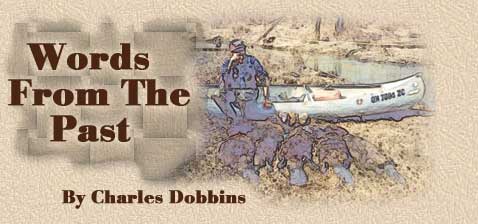Bedding Traps at Water Sets
by Charles L. Dobbins
(This article was published in the January 1991 issue of The
Trapper and Predator Caller)
When I place a trap underwater
at a set location, I make sure the trap is bedded as solidly as possible.
This underwater trap may be at the base of a muskrat slide, or at the mouth
of a pocket. The trap could be in a shallow water trail, or at a castor
mound set made for beaver.
When I place a trap underwater, I rarely cover
it. If the set was made for mink or otter, I sometimes will place a
few water-soaked leaves or other decaying vegetation over the trap, but just
enough to break up its outline. If the trap was placed on bottom without
digging a bed for it, this would be like placing a trap in front of a dirt
hole without digging a bed for it.
If the trap was placed in front of a dirt
hole, and there was no bed dug so the trap would be level, or slightly below
the level of the surrounding area, this would leave the hump of sifted dirt
over the trap. (Can you just see a wild canine "pussy footin" around
a hump of sifted dirt that contains a trap in front of a dirt hole?)
Why do I dig a bed for my traps when they
are underwater, even though the bottom at most locations has mud, silt, decaying
leaves and usually an unstable bottom? There are several reasons for
this.
1. It will get the trap down level or
slightly below level of its immediate surroundings.
2. If the set was made for beaver or
otter, there is less chance of the animal's chest making contact with the
trap and the trap grabbing onto just chest hair and skin, especially in shallow
water where the trap might be less than four or five inches underwater.
3. If the trap is not in a bed, the
animal could put its weight on the loose jaw, spring lever or on the end
of the cross frame where the dog is attached, and the trap can tip and fire
without getting a hold of the animal. With the trap placed in the dug
out bed, the animal can put its weight on the loose jaw or other part of
the trap, and most of the animal's foot will be on the more solid area outside
of the trap bed. Since the trap is level or slightly lower than its
surroundings, the trap will not be tipped over or fired when I check it.
4. The raccoon has a habit that causes
it to fire traps. The raccoon does not do this because it knows this
is a trap, but it is one of the many habits of the coon. I am sure
we all have had a trap set at a shallow underwater trail, or in the water
where these animals were going around an obstruction close to shore, and
the trap was fired or moved a few inches from its original position.
Raccoons do this, not because they know it was a trap, but when they stepped
on some part of the trap other than the pan, the tap moved.
It is a known fact that raccoons eat crawdads,
salamanders, small fish and snails which hide under flat loose stones, a
waterlogged piece of bark or other underwater objects. When the unbedded
trap moved beneath the raccoon's foot, the animal assumed there could be
a morsel of food beneath this object. the raccoon will slip its paw under
the trap to search. In doing so the raccoon turned the trap over or
moved it aside a few inches.
It can be seen that a trap which is bedded
properly has a better chance of catching any animal. It is just as
important for the trap set in the water to be stable, as it is for the trap
at the dirt hole to be bedded solid.
There can be exceptions to this, such as a
#3 or #4 trap and a mink or muskrat steps on some part of the unbedded trap
other than the pan. These smaller animals probably wouldn't tip these
larger size traps. However, if the trap is a #1, #1 1/2 and some #2's,
this tipping could result in a fired trap.
Beaver and raccoons are the greatest at firing
unbedded traps. It isn't that these animals know what they are doing,
it is their physical makeup that causes fired traps in some instances.
Both of these animals have large back feet. For the beaver, I prefer
my foot holds to have a jaw spread greater than six and one half inches.
Another animal that can inadvertently fire unbedded traps is the nutria.
This animal also has large back feet
. For the animals with large rear feet use
a trap with a jaw spread wide enough to accommodate the back feet of these
animals. Above all else, be sure the underwater trap is bedded solid.
A bed for the smaller traps can be made with the heel of a boot in most situations.
With the larger traps, I use a small shovel to dig the trap beds.

